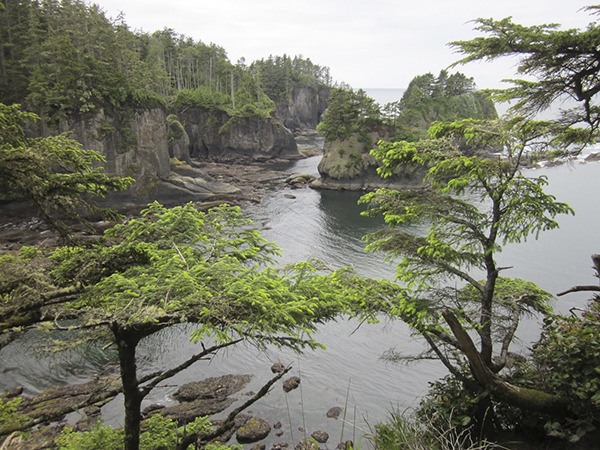Most Americans know plenty about our national parks and probably have visited several of them. Folks here on the peninsula treasure our exquisitely beautiful crown jewel, Olympic National Park.
Lesser known are the nation’s 14 marine protected areas (13 marine sanctuaries and one marine national monument), which are similar to national parks except they’re in the water.
You may not be aware that the Olympic Peninsula claims a second breathtaking crown jewel, Olympic Coast National Marine Sanctuary (OCNMS).
Our sanctuary’s waters span 135 miles down the outer coast, from Cape Flattery to just north of the Copalis River, and extend 25-50 miles outward into the ocean. Nearly two and a half times the size of Olympic National Park, OCNMS is home to a magnificent array of marine mammals such as whales, dolphins, porpoises, seals, sea lions and sea otters. Other wild inhabitants include the extremely rare leatherback sea turtle and strange-looking ocean sunfish, along with salmon, halibut, rockfish, skate and many other species.
The coastline is a mixture of cobble and sandy beaches, with fantastic tidepools. Rugged cliffs and shorelines are dotted with islands called “sea stacks” or “needles.” Three deep sea canyons are found within the sanctuary, the deepest of which is Quinault Canyon. At 4,600 feet deep, Quinault Canyon is about the same distance from sea level as the summit of Mount Storm King. The sanctuary’s numerous off-shore islands serve as important breeding grounds for many seabirds (including common murres, auklets, cormorants, among others) as well as marine mammals.
For centuries, Olympic Coast waters have provided a bountiful livelihood to the tribes that live there, including the Makah Nation, Hoh and Quileute tribes and Quinault Indian Nation. Later, ships arrived carrying American and European explorers, and eventually a new wave of settlers flooded the region. These people also came to depend on the generosity of the sea to stay alive.
One of the missions of the sanctuary is to “protect those irreplaceable legacies” and preserve the fascinating history of the Olympic Coast. This includes researching many famous and infamous shipwrecks, with over 200 documented in OCNMS. The details of several of these tragic events have been uncovered but other vessels simply vanished in the misty waters, never to be heard from again.
It was a shipwreck that became one of the driving forces behind the creation of the sanctuary. On June 22, 1991, a Japanese fish processing vessel called the Tenyo Maru was working about 25 miles northwest of Cape Flattery, at the mouth of the Strait of Juan de Fuca. It had a crew of 85 and contained 450,000 gallons of bunker fuel and diesel oil. Seas were calm that morning but a dense fog had settled over the water.
Also in the area was a Chinese vessel called the Tuo Hai. Despite warnings from nearby fishing boats, the Tuo Hai traveled through the fog at high speed and sliced into the Tenyo Maru, cutting the larger vessel in half. The Tenyo Maru sank immediately, leaking its fuel and oil into the pristine waters. Though only one man was killed, the resulting oil slick contaminated the coastline from Vancouver Island to Oregon. The worst of it hit shore on Makah lands. Though the owners of the Tuo Hai paid a $9 million fine, the massive cleanup job was left to locals.
Three years later, the Olympic Coast National Marine Sanctuary was established.
Though fishing is allowed, the sanctuary waters are protected from exploration and development, which means you won’t see oil rigs or canneries there. Large ships (400 gross tons or heavier) and vessels carrying oil or other hazardous materials mostly stay out of the sanctuary’s “Area To Be Avoided,” though they are not required to by law.
Managed by the National Oceanic and Atmospheric Administration, our sanctuary includes a local staff of resource managers, scientists and educators. A research vessel called R/V Tatoosh that operates predominantly out of LaPush and Neah Bay is used to deploy and maintain oceanographic equipment that monitors physical and biological aspects such as temperature, salinity, dissolved oxygen, nutrients and other data important to gauge the health of the marine ecosystem.
OCNMS operates a free and friendly visitor center on the waterfront in Port Angeles called the Olympic Coast Discovery Center, which serves to educate visitors about the sanctuary and issues critical to ocean conservation. You can visit the museum during the summer, seven days a week from 10 a.m.-5 p.m. at 115 E. Railroad Ave. and on weekends through October.
For more information, check out the website at http://olympiccoast.noaa.gov/welcome.html.
Carol Turner is docent at the OCNMS’s Olympic Coast Discovery Center.



